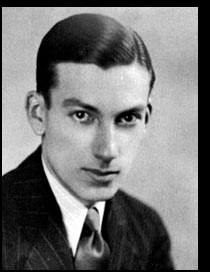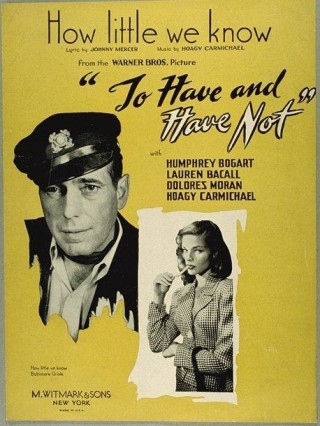*Post written by Mona Meyer, Archives and Special Collections Metadata Librarian.

Sheet music of Georgia on my Mind, n.d. Source: https://bit.ly/2XwIau9
You may know that this lyric is from “Georgia on my Mind,” but did you know that its author was not a son of the South, but rather a native Hoosier? Born in Bloomington on November 22, 1899, Hoagland Howard Carmichael, much better known as Hoagy, was the first of three children born to a father who struggled to support the family and a mother who was likely the source of his musicality. To help make ends meet, his mother played the piano for dances at Indiana University as well as to accompany silent movies. Ragtime music was all the rage, and the infant Hoagy often fell asleep to its syncopated rhythms when he accompanied his mother on her gigs.
Following the job market, the family lived for a few years in Indianapolis, where the teenage Hoagy was introduced to the hottest new musical style, jazz. WWI was raging and the 18-year- old Hoagy wanted to enlist but was too skinny. He managed to put on the required weight and signed up November 10, 1918. His was not a long enlistment as the armistice was signed the very next day and he returned home and soon back to Bloomington to try to finish high school. He began to hang out with college students, gaining instant popularity when they found out he could play jazz music. Managing to attain his high school diploma through a by-mail course, he enrolled at Indiana University in 1920 and became a Kappa Sigma brother.

Portrait shot of Hoagy Carmichael, n.d. Source: http://www.redhotjazz.com/hoagy.html
Carmichael began law school in order to have a career that would provide him stability and a good living. He maintained a small band through his college years, and in 1922 he met someone who would become a friend and strong influence, Bix Biederbecke. He graduated in 1925 and earned his law degree in 1926, and then off to begin his legal career. “By his own account, in 1927 Carmichael worked as a law clerk in West Palm Beach, Florida. There another life-shaping incident occurred. At a radio store he happened to hear a sidewalk phonograph playing a recording of his “Washboard Blues” and he rushed over to learn more. He was so thunderstruck and impressed by the unfamiliar recording by cornetist Red Nichols’s band, that he decided to abandon law and make music his life.” (Classic, p. 7) Later that same year he composed and recorded what became one of his best- known pieces, “Stardust.” Take a listen below to a 1941 recording—the original was only instrumental. Mitchell Parish wrote the lyrics. Click here to listen to a 1941 recording—the original was only instrumental. Mitchell Parish wrote the lyrics.
Pursuing the big time, Carmichael moved to New York in 1929, where he mingled and recorded with the best musicians, including Louis Armstrong, Benny Goodman, and Glenn Miller. His music was very popular, but he was starting to lose interest in jazz. In 1936 he moved to Hollywood to follow the siren song of pop music and the glitz and glamour of “the big time.”

“To Have and Have Not” Sheet Music, n.d. Source: https://bit.ly/31UMId9
And hit it big he did! Carmichael worked as a songwriter for Paramount Pictures as well as producing songs independently. He also worked in movies as an actor, appearing in 1937’s Topper with Cary Grant and Constance Bennett (uncredited as the piano player) and 1944’s To Have and Have Not with Humphrey Bogart and Lauren Bacall. He hosted and appeared on popular radio and television shows, toured all over the country, and played for 2 weeks at the London Palladium. His composition, Stardust, has been recorded over 1500 times. Performers as diverse as Louis Armstrong, Bing Crosby, Ethel Waters, Artie Shaw, Billie Holiday, Frank Sinatra, Ella Fitzgerald, Ray Charles, and Wynton Marsalis have recorded Carmichael’s music. He won an Academy Award in 1952 for best original song for his collaboration with lyricist Johnny Mercer on “In the Cool, Cool, Cool of the Evening,” sung by Bing Crosby in the Frank Capra-directed Here Comes the Groom. In 1971 he was in the inaugural class inducted into the Songwriters Hall of Fame. Hoagy Carmichael died in California December 27, 1981, and was buried in Bloomington on January 4, 1982. “His family donated his archives and memorabilia to Indiana University, which in 1986 opened the Hoagy Carmichael Room in his honor. In 1988, the Indiana Historical Society and the Smithsonian Institution issued a lavishly illustrated boxed set of recordings, The Classic Hoagy Carmichael, which earned Grammy Award nominations for Best Album Notes and Best Historical Album.” (Hoagy Carmichael Collection/Indiana University website)

Hoagy Carmichael Statue at Indiana University, 2008. Source: http://newsinfo.iu.edu/news-archive/8766.html
Since 2008, this statue of Hoagy has graced the IU campus, outside the Auditorium. Although he wrote only the music, not for “In the Cool, Cool, Cool of the Evening,” they seem appropriate here:
“In the cool, cool, cool of the evening
Tell ’em I’ll be there
In the cool, cool, cool of the evening
Better save a chair
When the party’s gettin’ a glow on
And singin’ fills the air
In the shank of the night
When the doin’s are right
You can tell ’em I’ll be there.”
Resources Consulted:
The Classic Hoagy Carmichael. Indianapolis: Indiana Historical Society/Washington, D.C.: Smithsonian Collection of Recordings, 1988. UASC Regional Collection M3.1 .C37
The Star Dust Melodies of Hoagy Carmichael. Melville, NY: Belwin Mills Publishing Corp., 1983. UASC Regional Collection M1630.18 .C27 1983
